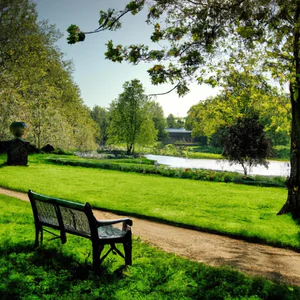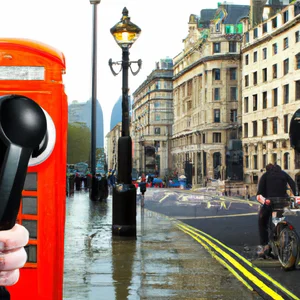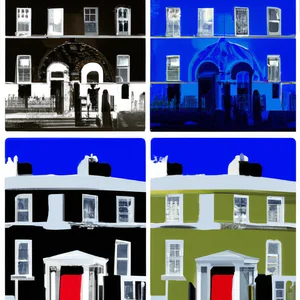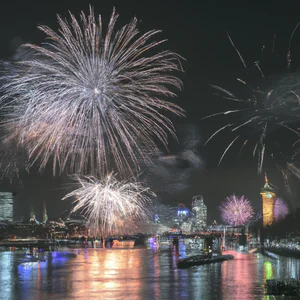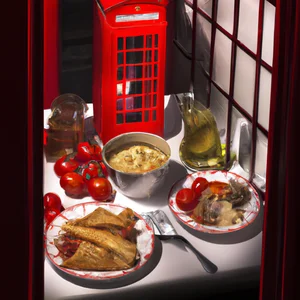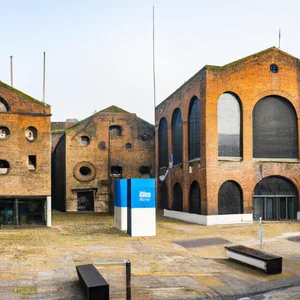Book your experience
South Bank: culture, art and breathtaking views along the Thames
The South Bank is truly a place that will leave you speechless! When you go there, it feels like you’re in the beating heart of London’s culture and art. There are so many things to see and do, it’s like a buffet of experiences, where you can enjoy a little bit of everything.
Imagine walking along the Thames, with the wind ruffling your hair and the smell of street food making your mouth water. Every corner has something to offer: from museums, such as the Tate Modern, which is a real jewel for those who love contemporary art, to the fantastic markets where you can find everything from handmade souvenirs to delicious snacks to enjoy.
And then there are those views that leave you speechless, like the London Eye which, believe me, is an experience you have to try at least once in your life. The view from above is like a painting that moves before your eyes. I can’t forget when I went there with a friend, we were there chatting and laughing, and suddenly, the sun was setting, and the sky was tinged with such beautiful colors that it seemed like a dream.
In short, the South Bank is a perfect mix of culture and beauty, but I don’t know if it’s exactly the ideal place for those seeking tranquility. There are always people around, and sometimes it can be a bit chaotic. But, hey, that’s the beauty of London, right? Life that flows, continuous movement.
In any case, if you’ve never been there, I recommend you check it out. Maybe you could even catch some live events or performances, because here art is really close at hand, and makes you feel part of something big. I think everyone should take a moment to enjoy all that the South Bank has to offer, because it is a place that fills your heart and mind with ideas and inspiration.
Discover contemporary art at the Tate Modern
A Personal Experience
I still remember my first encounter with the Tate Modern. It was a sunny day in London and, crossing the Millennium Bridge, my gaze fell on the majestic former power station, which has now become a temple of contemporary art. Upon entering, I was immediately enveloped by the vibrant energy of the works on display. I felt an indescribable sensation, a fusion between the modern and the classic that only a place like this can offer.
Practical Information
Located along the River Thames, Tate Modern is easily accessible by public transport. The nearest tube stop is Southwark (Jubilee Line), or you can opt for a walk along the river. Entry to the permanent collections is free, but it’s advisable to book in advance for the temporary exhibitions, which usually attract large crowds. You can find updated information on the official Tate Modern website.
An Unconventional Advice
Many visitors focus on the most famous works, but one insider suggests you explore level 5. Here, you’ll find a rooftop terrace with spectacular views of the London skyline, perfect for a contemplative break. Also, don’t forget to visit Turbine Hall, where temporary installations often challenge perception and stimulate critical thinking.
Cultural and Historical Impact
The Tate Modern is not just a museum; it is a beacon of contemporary culture. It opens the doors to new forms of artistic expression, reflecting the social and political transformations of our time. Through its commitment to accessible art, the museum has democratized contemporary art, making it accessible to an ever-wider audience.
Sustainable Tourism
Tate Modern promotes responsible tourism practices. For example, it encourages the use of public transportation and offers dining options that use local, sustainable ingredients. Choose to sip coffee at their rooftop bar, where every sip supports local producers.
Immersion in the Atmosphere
Walking through the rooms of the museum, it is impossible not to feel part of something bigger. Installations by artists like Damien Hirst and Yayoi Kusama captivate you with their vibrant colors and bold concepts. Each work tells a story, a fragment of our contemporary reality, and invites you to reflect on your position in this vast world.
An Activity to Try
If you have a little extra time, a contemporary art workshop at the Tate Modern could be the perfect experience for you. These events allow you to explore your creativity under the guidance of expert artists, offering a unique way to interact with art.
Myths and Misconceptions
A common misconception is that contemporary art is incomprehensible or elitist. By contrast, Tate Modern is committed to making art accessible to all, with clear explanations and interactive activities that engage every visitor, regardless of their level of artistic knowledge.
A Personal Reflection
After exploring the Tate Modern, I asked myself: How willing am I to let art influence my daily life? The beauty of contemporary art is precisely this: it challenges us, inspires us and invites us to look at the world with new eyes. I invite you to live this experience and discover how it could affect your life too.
Walk along the Thames: unforgettable views
A personal experience along the banks of the Thames
I still remember the first time I walked along the Thames. It was a spring day, the clouds parted and the sun’s rays reflected on the sparkling water. The feeling of freedom was palpable as I ventured along the route that connects the various iconic points of London. Every step was accompanied by the lively sounds of the city, from outdoor cafes serving a selection of afternoon teas to street musicians livening up the atmosphere. This place is not just a simple avenue; it is a celebration of life, art and culture that blends into an unforgettable panorama.
Practical and up-to-date information
The walk along the Thames extends for approximately 7 miles, from Battersea to Tower Bridge, and offers breathtaking views of some of London’s most iconic landmarks, such as the London Eye, Big Ben and the Tower of London. Along the route, you will find rest areas, kiosks and viewpoints for taking unforgettable photos. For up-to-date information, you can visit the official Visit London website, which offers details on riverside attractions and local events.
A little-known tip
A tip that only an insider knows is to discover the small art galleries and artists’ studios hidden along the route. Many of these places are not advertised, but offer open events and temporary exhibitions that can be unique experiences. Keep an eye out for the wooden signs reading “Open Studio” as you stroll, and don’t hesitate to pop in for a truly authentic experience.
Cultural and historical impact
The Thames is not just a river; it is the beating heart of London, a silent witness to the city’s history. For centuries, its shores have been the stage for historical events, from maritime trade to public celebrations. Walking along the river allows you to immerse yourself in this rich historical narrative, while the monuments and museums that dot the route tell stories of a vibrant past and an ever-evolving culture.
Sustainable tourism practices
In an age where sustainability is key, walking along the Thames offers an eco-friendly alternative to public transport. The route is easily accessible on foot and, for those who prefer, it is possible to rent bicycles to explore the area in a sustainable way. Additionally, many riverside restaurants and cafes are committed to using local ingredients and practices eco-friendly.
An activity worth trying
Don’t miss the opportunity to take a guided kayak tour on the Thames. This will allow you to see the city from a completely new perspective, with the ability to approach historic places from a close distance. Several companies offer tours suited to all experience levels, making this activity both fun and educational.
Addressing the myths
A common misconception is that the walk along the Thames is only for tourists. In reality, it is a meeting place for Londoners, who go there to relax, socialize and enjoy the beauty of the river. It is an authentic experience that unites people from all walks of life.
Final reflection
Walking along the Thames is an experience that invites reflection. Have you ever wondered what it really means to “live” a city? As you walk along its banks, surrounded by history, art and culture, you realize that London is not just a destination, but an ongoing journey of discovery. What stories could you tell after exploring this extraordinary path?
Hidden History: Borough Market
A journey through time among the stalls
I vividly remember my first visit to Borough Market; its cobbled streets seemed to tell centuries-old stories, while the scent of spices and fresh produce mixed with the crisp London air. As I walked among the stalls, I came across an elderly cheese seller who, with a smile, told me how his family had been part of this market since the 1800s. This chance encounter was an experience that enriched the my trip, making it not just a moment of shopping, but an immersion in culture and tradition.
Practical information and updates
Borough Market, one of London’s oldest food markets, is open every day, but Wednesdays and Thursdays are the best days to visit, when the stalls are less crowded. Inside this lively market, you can find an incredible variety of foods, from fresh produce to artisanal delicacies. According to the official Borough Market website, visitors can also participate in tasting events and cooking classes that take place regularly, making the visit even more interactive and engaging.
Unconventional advice
An insider from the area told me a secret: visit the market early in the morning, before the official opening, to watch the preparation of the stalls and discover the vendors offering free tastings to passers-by. This little trick will allow you to get to know the local community better and sample some delicacies before the market fills up with tourists.
A cultural heritage rich in history
Borough Market is not just a place to buy food, it is also an important symbol of London’s culinary history. Founded in 1014, it has served as a trading point for goods since medieval times. Today, its colorful stalls and variety of products reflect the multiculturalism of the British capital, uniting culinary traditions from all over the world.
Sustainability and responsibility
In an age where sustainability is key, Borough Market is committed to promoting responsible tourism practices. Many vendors offer local and organic products, thus reducing the environmental impact of transportation. Choosing to purchase from these suppliers not only supports the local economy, but also helps preserve the environment.
An experience not to be missed
For a unique experience, don’t miss the opportunity to take part in one of the market’s guided tours, where local experts will guide you through the stories of the vendors and products. Furthermore, you can try a “food tour” that will take you to taste the regional specialties offered by the various stalls. It’s a perfect opportunity to explore London gastronomy at 360 degrees.
Myths and misconceptions
A common misconception is that Borough Market is just for tourists, but in reality it is a lively social hub for locals. Many people from the area go there regularly to do their weekly shopping, and the market is a place where families meet and share moments of conviviality.
A personal reflection
The visit to Borough Market made me reflect on how important places are that preserve the traditions and culture of a community. What do you think? Have you ever visited a local market that left a lasting impression on you? Next time you’re in London, take the time to explore this historic and tasty corner of the city, and discover the stories behind each stall.
Unmissable cultural events at the Southbank Centre
I still remember the first time I walked through the doors of the Southbank Centre. It was a spring evening, and the air was filled with a mix of enthusiasm and anticipation. A group of street performers performed a lively dance, while the scent of caramel popcorn wafted through the air. My attention was immediately caught by an impromptu event: a slampoetry performance that captivated the audience with powerful verses and life stories. This is the beating heart of the Southbank Centre, a place where culture mixes with everyday life, making every visit a unique and memorable experience.
A hub of creativity and innovation
The Southbank Center is one of Europe’s leading cultural centres, hosting events ranging from music to dance, theater to visual arts. Opened in 1951, the architectural complex is made up of several buildings, including the Royal Festival Hall and the Hayward Gallery, which offer varied and stimulating programming. Every year, the center attracts millions of visitors, all eager to immerse themselves in London’s vibrant cultural scene.
To stay up to date on upcoming events, I recommend you visit the Southbank Centre’s official website, where you will find detailed information on upcoming shows and special events such as the London Literature Festival and the Meltdown Festival, curated by renowned artists.
An insider tip
A little trick that only locals know is to take advantage of the “pop-up performances”, free events that take place sporadically in various corners of the center. Often, these performances can be found simply by strolling along the riverfront, and are a fantastic way to discover emerging talent without spending a penny.
The cultural impact of the Southbank Centre
The Southbank Center is not just an entertainment venue; it is also a symbol of cultural resilience. It has played a crucial role in promoting contemporary art and giving voice to diverse communities. Throughout its history, it has hosted events that have addressed social and political issues, helping to shape the UK’s cultural debate.
Sustainability and responsible tourism
In the current environment, the Southbank Center is actively committed to implementing sustainable practices. From initiatives to reduce waste to programs that promote social inclusion, the center is an example of how art can work for the good of the community and the environment. Participating in events here also means supporting a larger cause.
Soak up the atmosphere
Imagine sitting on a bench outside, surrounded by artists and creatives, as the sun sets over the Thames. The lights of the boats sparkle on the water, and the music of the events mixes with the sound of the waves. This is the Southbank Centre, a place where art and everyday life intertwine in surprising ways.
Activities to try
If you’re visiting during a special event, don’t miss the opportunity to participate in a contemporary art workshop or a theatrical improvisation session. These experiences will not only enrich your visit, but will also allow you to interact with artists and other culture enthusiasts.
Myths and misconceptions
A common myth is that the Southbank Center is exclusive or inaccessible. In fact, many events are free or low-cost, and there are always opportunities for everyone to participate and enjoy the culture. Furthermore, the welcoming atmosphere makes the center an ideal place for everyone, from tourists to residents.
A new perspective
Next time you visit London, I invite you to consider the Southbank Center as an unmissable stop on your itinerary. What stories and connections might you discover by attending a cultural event? Let yourself be guided by art and creativity, and discover how these elements can enrich your travel experience.
Culinary Experiences: Enjoy local street food
An unforgettable encounter with street food
The first time I visited South Bank, I found myself in a small, fascinated crowd, all glued to the various street food stands that line the riverfront. It was a sunny day and the air was filled with delicious aromas: exotic spices, grilled meats and freshly baked pastries. Between one tasting and another, I ran into a seller of Venezuelan arepas, whose contagious smile immediately won me over. Savoring that food, while admiring the view of the Thames, was an experience I will never forget.
Discover the best of street food
South Bank is a true paradise for street food lovers. Every weekend, the Southbank Center Street Food Market comes alive with a variety of dishes from around the world. Don’t miss out on local specialties like gourmet fish and chips or fresh scones. For up-to-date information on stands and events, you can consult the [Southbank Centre] official website (https://www.southbankcentre.co.uk).
An insider tip
If you really want to immerse yourself in the food culture of the South Bank, visit Borough Market during the week. While weekends are crowded, during the week you can enjoy a quieter experience and have the chance to chat with the vendors. Many of them are passionate artisans and are happy to share stories about their food and the culinary traditions they represent.
The cultural impact of street food
Street food on the South Bank isn’t just about taste; it represents a crossroads of different cultures that meet and mix. This area of London, historically a center of exchange and innovation, continues to live on through its culinary experiences, reflecting the diversity of the city and the influence of global cultures. Every bite tells a story, a journey from one corner of the world to another.
Sustainability and responsibility
An important aspect to consider when exploring street food is sustainability. Many vendors on South Bank are committed to using local and seasonal ingredients, thus reducing their environmental impact. Some stands also offer vegetarian and vegan options, promoting more responsible food choices. When choosing a dish, look for labels that indicate sustainable practices.
An experience worth trying
I recommend you try the bao buns from one of the many vendors. These soft and fluffy buns of Asian origin are filled with tender meat and fresh vegetables, and are a real comfort food. Eating them while watching the river and the boats passing by is an experience that will make you feel part of the lively London life.
Myths and misconceptions
A common misconception about street food is that it is always unhealthy. In fact, many vendors strive to offer fresh and nutritious options. Be careful to choose freshly prepared dishes made with quality ingredients, and you’ll find that street food can be delicious and healthy.
A personal reflection
As I savored my arepas and admired the view of the Thames, I realized how much street food can bring people together. What dish would you like to try while exploring the wonders of the South Bank? Next time you visit London, remember that food is a journey, and every dish is an opportunity to discover a new story.
Sustainability: responsible tourism on the South Bank
A personal experience
I still remember the first time I walked along the South Bank of the Thames. The fresh air mixed with the scent of markets and street cuisine, while the sound of laughter and music filled the atmosphere. While I was enjoying the view of the city, I noticed a group of volunteers busy cleaning the shore. This gesture of care for the environment impressed me and increased my desire to explore the sustainable side of London.
Practical information
South Bank is not only a place of beauty and culture, but also an example of responsible tourism. Several initiatives have been implemented to promote sustainable practices. Visit the Southbank Centre, which not only hosts cultural events, but is also involved in sustainability projects, such as recycling and the use of renewable energy. Additionally, Borough Market offers local and organic produce, supporting area producers. You can find further details about their projects on the official website (southbankcentre.co.uk).
Unconventional advice
An insider tip: take part in one of the guided eco-walks organized by Green Tour London. These experiences will not only lead you to discover the beauty of the South Bank, but will also provide you with valuable insights into the city’s sustainability practices. A fantastic way to explore London while learning to respect and preserve the environment.
Cultural and historical impact
The South Bank has a rich history of transformation and innovation. Once an industrial area, today it is a pulsating center of art and culture, where sustainability plays a crucial role. The area has become a model of how tourism can coexist with environmental responsibility, influencing not only local policies but also tourist behavior.
Vivid atmosphere
Imagine strolling along the riverfront, surrounded by street performers and musicians, as the sun sets and lights up London’s skyscrapers. The feeling of being part of a community that cares about its environment is palpable. Every step along the South Bank is an invitation to reflect on how our daily actions can contribute to a more sustainable future.
Activities to try
Don’t miss the chance to visit the London Eye, which has recently implemented greener practices, such as LED lighting. After a scenic run, take a stroll in nearby Jubilee Gardens, a regenerated green area that offers an oasis of tranquility in the heart of the city.
Myths to dispel
A common misconception is that sustainable tourism is more expensive. In fact, many of the most authentic and memorable experiences on the South Bank, such as the markets and eco walks, are accessible and sometimes even free. By choosing to support local businesses and sustainable practices, you not only save money, but you also contribute to a more responsible economy.
Final reflection
As you explore the South Bank, ask yourself: How can I make a difference on my trip? Every small gesture counts and every choice you make can have a positive impact. Next time you find yourself in the British capital, consider embracing more responsible and sustainable tourism. The beauty of London is not only in its attractions, but also in its ability to inspire positive change.
The architectural jewel: the Millennium Bridge
A surprising encounter
I still remember the first time I crossed the Millennium Bridge, an experience that has remained etched in my mind. The sun was setting, painting the sky in shades of orange and pink, while the Thames shimmered beneath my feet. The structure, with its elegant and modern design, appeared to float above the river, uniting the historic St. Paul’s Cathedral with the dynamic Bankside neighborhood. Despite its recent origins, the Millennium Bridge has already earned a special place in the hearts of Londoners and visitors.
Practical information
Opened in 2000, the Millennium Bridge is a pedestrian bridge designed by architect Sir Norman Foster and engineer Sir Anthony Hunt. Its length of 325 meters makes it one of the longest bridges in London. It is open to the public 24 hours a day and offers breathtaking views of some of the capital’s most iconic monuments. You can easily reach it by public transport, getting off at Blackfriars or St. Paul’s station.
An insider tip
Here’s a little secret: if you want to enjoy the view without the crowds, visit the bridge at sunrise. The tranquility of the morning, together with the reflections of the water, creates an almost magical atmosphere, perfect for a contemplative walk. Also, bring a camera – the opportunities for taking stunning photographs are endless!
Cultural and historical impact
The Millennium Bridge is not just an architectural attraction; it is a symbol of connection between past and future. Its construction marked a period of renewal for London, in which new forms of architectural expression were sought. The structure was designed to resist seismic events and the strong currents of the Thames, representing an example of cutting-edge engineering.
Sustainability and responsibility
As a pedestrian bridge, the Millennium Bridge encourages sustainable modes of transportation. Walking or cycling to explore London not only reduces your environmental impact, but also offers a way to discover the city in a more intimate and personal way. Remember to respect your surroundings and collect any waste you may find along the way.
An unforgettable experience
For a truly unique experience, consider visiting the bridge during one of the special events, such as the ‘Thames Festival’ or the ‘London Bridge Festival’. These events offer artistic and cultural performances that make the visit even more memorable.
Myths and misconceptions
A common misconception is that the Millennium Bridge is just a work of art and has no functionality. In fact, it is an important transit route for pedestrians and cyclists, and its original design faced significant technical challenges to ensure safety and stability.
A new perspective
As you walk along the Millennium Bridge, take a moment to reflect on what it represents: a link between cultures, a symbol of innovation and an invitation to explore. What does crossing a bridge mean to you? The next time you are in London, ask yourself how this simple structure can enrich your experience of the city.
Sunset views: the London Eye and beyond
It was a cool spring evening when the golden light of sunset began to paint the sky above the Thames. I stood on the South Bank, sipping hot tea from a kiosk and watching the world move around me. The atmosphere was magical: the London Eye stood out majestically against the sky, while the waters of the river reflected a palette of colors that went from pink to orange. This is the moment I realized that South Bank is not just a place to visit, but an experience to have.
An unparalleled panorama
The London Eye, with its height of 135 metres, is not only one of London’s most iconic tourist attractions, but also offers spectacular panoramic views of the city. If you want to avoid long queues and groups of tourists, I recommend you visit it during sunset, when the crowds thin out and the colors of the sky create an enchanting atmosphere. The transparent capsules will allow you to admire not only London Bridge and the Palace of Westminster, but also the Big Ben bell tower in all its glory, while the sun hides on the horizon.
A typical insider
A little-known tip: if you want an alternative to the London Eye, try going up to the panoramic terrace of Sea Containers London. This hotel is not only a place to stay, but also offers a bar with stunning views of the river. Here you can enjoy a cocktail while the sun sets, surrounded by an elegant and relaxed atmosphere.
The cultural impact
The sunset views from the South Bank aren’t just postcard-worthy scenery; they tell the story of a city that constantly evolves. This once industrial neighborhood has become an epicenter of creativity and culture. Its architectural beauties, such as the National Theater and the Tate Modern, blend perfectly with the river panorama, creating a unique context that attracts artists, writers and visitors from all over the world.
A sustainable approach
While enjoying the sunset, consider adopting responsible tourism practices. Walking along the riverbank, rather than using transport, will allow you to truly appreciate the beauty of the South Bank, helping to reduce environmental impact. Furthermore, many restaurants in the area have committed to using local and sustainable ingredients, offering an environmentally friendly dining option.
Immerse yourself in beauty
Imagine being there, with the wind lightly ruffling your hair, while the sky is tinged with warm shades. This is the perfect time for a walk along the Thames, which not only offers spectacular views, but connects you with the pulsating soul of London. If you’re lucky, you might even come across a street performer who adds a touch of magic to the evening.
A new perspective
Many think that the London Eye is just another tourist attraction, but I hope that, after reading this, you see beyond its light-up wheels. The beauty of the sunset on the South Bank is an invitation to reflect on how profound and vibrant urban life can be. What story does the panorama before you tell you?
Come and discover South Bank: it will not just be a place to visit, but an experience that will enrich your trip.
Unconventional tip: Explore the secret gardens
A personal anecdote
The first time I discovered the secret gardens of the South Bank it was almost by accident. While walking along the riverside, attracted by the music and laughter, I found myself in front of a small green door, slightly open. Curiosity took over and, once I crossed the gate, I found myself in an oasis of tranquility, away from the hustle and bustle of the city. That experience made me understand that, even in a lively metropolis like London, there are hidden corners that tell stories of peace and beauty.
Practical information
The secret gardens of the South Bank aren’t always easy to find, but they’re worth seeking out. One of the best known is the Bankside Mix, a community garden that extends across the streets of Southwark and offers spectacular views of the Thames. Another jewel is the Garden of Remembrance, which celebrates the memory of the soldiers. Both places are easily accessible and open to the public. For updated information, you can check the Southbank Centre official website.
An insider tip
If you want to have a truly unique experience, visit these gardens in the early morning, when the sun rises and the colors are particularly vibrant. Bring along a book or a cup of coffee from one of the nearby cafes and enjoy the calm before the world wakes up. This moment of tranquility will allow you to reflect and appreciate the art of nature, a wonderful contrast to the frenzy of London.
Cultural and historical impact
Secret gardens are not just green spaces; they are a celebration of London’s community and resilience. They offer a refuge for artists, writers and thinkers, and represent a link to the city’s botanical traditions. Their presence in such a tourist area as the South Bank demonstrates how nature can coexist with art and culture, creating a harmonious balance.
Sustainable tourism
Visit these gardens responsibly. Respect the local flora and fauna, avoiding trampling on the flowerbeds and contributing to the cleanliness of the area. Choose to use sustainable transport, such as cycling, to reach South Bank, and consider a picnic of local produce purchased at Borough Market.
A dream atmosphere
Imagine walking among flower beds, surrounded by the scent of plants and the sound of birds. The secret gardens of the South Bank offer a unique sensory experience, where the brilliant colors of the blooms mix with the blue of the sky and the green of the vegetation. It’s a corner of serenity that will make you feel like you’re in a living painting.
An unmissable activity
After exploring the gardens, don’t miss the opportunity to attend a gardening or botanical art workshop, often held in these areas. These events will allow you to interact with the local community and learn sustainable gardening techniques.
Myths to dispel
A common misconception is that secret gardens are only for those who live nearby. On the contrary, they are open to all and represent an important part of London’s cultural heritage. You will be surprised how easy it is to access them and how welcoming they are.
Personal reflection
Next time you visit South Bank, take a moment to explore these gardens. I invite you to reflect on how nature can offer a refuge from the frenetic life of the city. What stories would these gardens tell you if they could talk?
Live music: the vibrant sound of the local scene
A Personal Experience in the Heart of the South Bank
The first time I stepped foot into one of the small live music venues on the South Bank, I had no idea what to expect. With the sound of acoustic guitars and voices mingling in the air, I found myself immersed in a vibrant and welcoming atmosphere. I still remember the smile of a musician who, after an intense performance, came down from the stage to chat with the audience. That evening, I discovered that the South Bank music scene is not just a place to listen to music, but a real meeting point for artists and music lovers, where every note tells a story.
Practical Information and Recent Updates
On the South Bank, there are numerous venues hosting live concerts, from the legendary Royal Festival Hall to the intimate Bargehouse. Every week, the programming varies, with events ranging from jazz to rock to electronic music. To stay up to date, I recommend consulting the official website of the Southbank Centre and local platforms such as DesignMyNight or Songkick, where you can find information on scheduled concerts and purchase tickets in advance.
Insider advice
A little-known tip: many of the up-and-coming musicians offer free concerts during the early evening hours. If you’re lucky, you might come across amazing talents who are trying to make their way into the music scene. Don’t forget to arrive early to ensure a good seat and, if you can, bring along a vinyl or CD of the artist for a possible dedication after the show!
The Cultural Impact of Music on the South Bank
Live music on the South Bank isn’t just entertainment; it is a powerful vehicle of cultural expression. This neighborhood is a crossroads of cultures, where artists of different origins come together to create unique experiences. The music reflects the diversity of London and helps keep British musical traditions alive, from iconic punk rock to contemporary jazz.
Sustainable Tourism Practices
When attending music events, consider using public transportation to get to the venues. London has an excellent public transport network, and choosing to travel by train or bus helps reduce your environmental impact. Additionally, many venues promote sustainable practices, such as using recyclable materials and reducing food waste.
Immerse yourself in the Atmosphere
Imagine walking along the river, the sound of music wafting through the air as the sun sets over the horizon. The warmth of the lights in the rooms reflects on the water, creating a magical atmosphere that invites you to stay and listen. Live music on the South Bank is an experience that involves all the senses, transmitting emotions that remain in the heart.
An Activity to Try
If you fancy a unique experience, join a jam session in one of the local pubs. Many of these venues offer open nights where anyone can get on stage and play. It’s an opportunity to see talented artists, but also to feel part of London’s music community.
Myths and Misconceptions
A common myth is that live music in London is always expensive. In fact, there are many opportunities to attend free or low-cost concerts, especially in smaller venues and street festivals. Don’t let price prejudice stop you from experiencing the city’s rich music scene.
A Final Reflection
After experiencing the beauty of live music on the South Bank, I asked myself: how many untold stories are behind each song? The next time you visit this neighborhood, ask yourself which artists have taken to that stage before you and what emotions they shared. Music is not just entertainment; it is a profound connection between people that transcends time and space. Are you ready to discover the vibrant sound of the local scene?

 Architecture and Design
Architecture and Design Cities and Regions
Cities and Regions Culture and History
Culture and History Events and Festivals
Events and Festivals Fashion and Shopping
Fashion and Shopping Food and Wine
Food and Wine Nature and Adventure
Nature and Adventure Unique Experiences
Unique Experiences



















